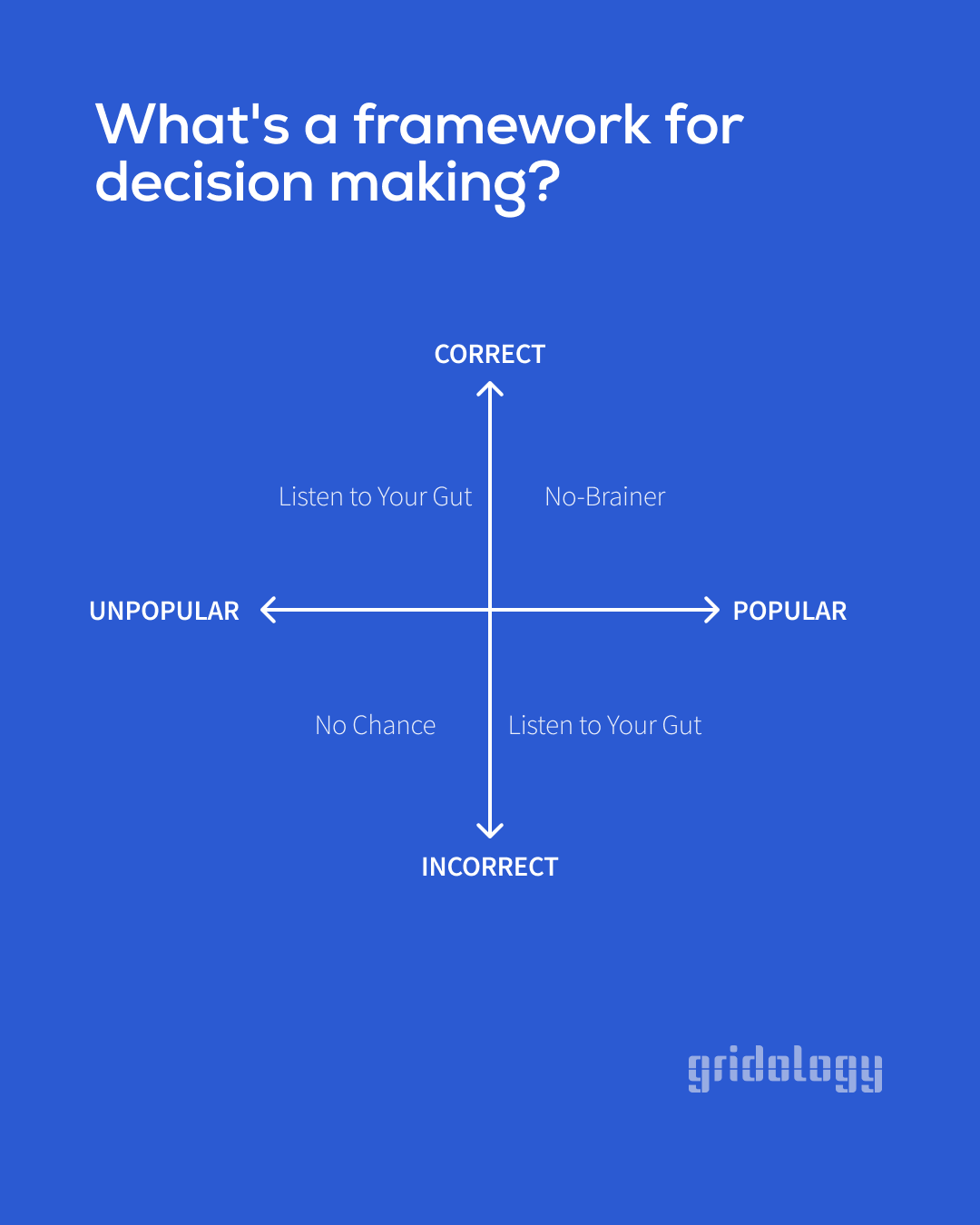4-min read
“What is right is not always popular and what is popular is not always right.” —Albert Einstein
Growing up, this quote was always top of mind. These words were engraved on a plaque on the side of a building at a summer camp I attended. I’d pass by these words every day. Einstein’s maxim quietly became the mantra of nearly every summer, and even today it helps define the man I hope I am and the man strive to be.
Today, I’m going to dive into the root question Einstein may have been looking to answer:
What’s a framework for decision making?
Obviously there are several frameworks you can use to make decisions, and like last week’s post, this question may very well turn into a broader series. In this grid, I’m tackling it from the vantage point of trusting your instincts.
The axes in this grid align with Einstein’s adage.
On the x-axis, we have the question: is it popular? There are many ways to assess popularity. For this grid, the way I’m choosing to think about it is if the choice you’re considering is chosen frequently by your friends or those offering input into the decision. For example, let’s say you are looking for a new job and get offers from two great companies. Your friends and family may advise you to accept a job at Company A. This would make Company A the popular choice, and, if you were to ultimately choose Company B, it would be mentally taxing on your psyche given its unpopularity.
On the y-axis, we have the question: is it right? Right and wrong can mean two different things. Does “right” mean the choice abides by the law? Or does “right” mean the choice is morally correct or align with your values? And, of course, morally correct will mean different things to different people. Sometimes the lawful and moral answer are one and the same, but sometimes they aren’t. For this grid, let’s say that “right” means the morally correct answer, or the one that aligns with your own belief system.

Understanding the Grid
This grid, instead of having four distinct zones or quadrants, has only three outcomes. This ultimately is the reason why Einstein’s wisdom boils down to an exercise in trusting your gut. Let’s jump in:
No-Brainer
This quadrant is for decisions that are both right and popular. Most of the time, these decisions are automatic—they’re choices that are obvious and engrained into everyone’s personality and social living code. They don’t require any mental effort. They don’t even require asking for advice or seeing what others would do in your situation. The choice is so obvious you know what to do without needing a second opinion. The decision is clearly a “yes,” making it an absolute no-brainer. These decisions take minimal time to make and ultimately lead to expected outcomes.
Listen to Your Gut
When the right choice and the popular choice are not the same answer, this is where listening to your gut becomes vital. When things are popular, but wrong, you have to trust your gut to not go with the crowd as choosing the right answer is mentally taxing. Likewise, when things are unpopular, but correct you have to also trust your gut to deviate from the crowd and choosing the right answer is still mentally taxing. Both scenarios are quite similar, in either situation you are choosing to not do something everyone else is or to do something everyone else isn’t. It may take a while to train your inner voice. This is what makes Einstein’s remark so remarkable. It cuts through the rest of this grid and illuminates the matter at hand: many of life’s most important decisions come from trusting your own intuition and not being afraid to deviate from the group.
No Chance
When a potential choice is unpopular and wrong there should be no question as to what you should do. Similar to the “No-Brainer” zone, this category is just the opposite: for as obvious it is to make a choice in the “No-Brainer” quadrant it is equally as obvious to not make a choice in this quadrant. These decisions are also made quickly as there shouldn’t be much internal debate. The choice is clearly morally incorrect and unpopular with those who also have a some type of a stake in the outcome.
Grid Shortcomings
Given this grid is a bit of an oversimplification, there are two shortcomings I want to address:
The redundancy of the grid can cause confusion. Making a choice is often the inverse of not making the other. So, in this respect, the “No-Brainer” and “No Chance” quadrants are identical in nature. I separated them here because of the different mental processes going on. One quadrant is based in action and the other is based in inaction. The reason the “Listen to Your Gut” quadrant appears twice is because the bigger choice is deviating from the crowd rather than doing or not doing something.
This grid ignores the law, but assumes being law-abiding is part of being morally correct. While this assumption most likely holds 99% of the time, pretty much every action movie ever made features characters who break the law to pursue a morally correct choice. Remember, morally correct is in the eyes of the person making the decision, not from the vantage point of anyone else.
What do you think of this interpretation? Would you think about it differently? Do you have any important quotes that were important to you while you were growing up? Write me. I’d love to hear from you.
Life’s only as confusing as you let it be,
Ross
If you enjoyed this issue of Gridology, please consider forwarding it to your friends, family or colleagues. If you have any feedback or have other ideas you’d like me to tackle, just reply back to this note!



